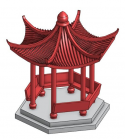What's the explanation behind the difference in turret recoil/stabilisation between Chinese (Type 99/99A specifically)/Russian tanks and western + South Korean tanks after firing a shot? Both Chinese and Russian tanks have the turret "bounce" upwards after a shot while the other tanks turrets don't really bounce but sort of just retract inward instead.
It has to do with inertia and its geometric distribution.
First of all there is a parameter called
second moment of area or, alternatively,
area moment of inertia. In Polish we use the term
geometric moment of inertia.
This property describes the spatial property of mass distribution which in turn determines how any geometric object will respond to a force acting on it since forces act on mass and if mass is spread over an area (or volume) then some parts of that mass will be acted on before other parts of that mass. When a force acts on a mass it imparts acceleration on that mass. Therefore if you have an object that has mass distributed across a volume and a force is exerted in one point of that volume there is a moment in time when the part of the object that is close to the point of exertion is already accelerating while other parts of the object are still stationary.. Force, as everything in the universe, is limited by the speed of light in vacuum. Any physical interaction cannot occur instantaneously but takes speed of light divided by distance to happen. This explains why you can topple over a bottle in zero gravity if you push it above its center of mass even though you are trying to move it horizontally. The top of the bottle accelerates while the bottom is stationary and instead of movement along the main axis you have rotation.
When a tank fires the gun the force which propels the round acts on the tank in equal amount as an equal but opposite vector. However the force does not have the same effect as it does on the round because what defines how a force is transferred has to do with geometry of the tank and distribution of mass. A round is small and compact and has low mass that is accelerated by high force of the explosion. A tank is large and not very compact and has high mass that is acted on by the force of explosion.
A tank also is acted on by gravity and friction which cause the tank to move in an angular fashion around the center point that is somewhere under the tank. Again, this is why if you put a bottle on the table and push it you can topple it. Gravity and friction keep the bottom in place while the force of your push accelerates the top of the bottle.
There's a parameter called
moment of inertia or
second moment of mass which defines how a mass behaves in angular (circular) motion and it is also influenced by geometry of the system, specifically the position of the center of mass with regards to the center point of the rotation.
If you compare western tanks and Russian tanks they have fundamentally different geometries and differ significantly in mass distribution. That determines how they behave when acted on by a force.
To make it more intuitive - western tanks and all derived designs are like Mike Tyson , a heawyweight, a stocky, powerful man, throwing body shots, Russian tanks and all derived designs are like a middleweight, a smaller boxer but with long hands and heavy fists throwing a haymaker. When a western tank fires a gun they get hit by the opposite of that body shot. When a Russian tank fires a gun they are hit by the opposite of that haymaker. Therefore western tanks seems to "step back" while Russian tanks "lean out".
Russia tanks have also lower manufacturing quality and weaker suspension so a lot of the momentum that the force imparts on the tank is distributed not along its mass geometrically but mechanically.
If you have a tightly fitted turret ring the turret will act with the chassis as almost the same thing. While the turret will want to move on its own it will quickly run into the rest of the tank and will transfer momentum. If you have a less tightly fitter turret ring - which is common in Russian tanks - then the turret will move on its own more with relation to the chassis. Russian turrets are also lighter, because they only need to fit two crewmen and have no primary ammo magazine. But they are firing a gun that is as powerful, if not more so, than western equivalent.
And that means that the turret in Russian tanks acts more independently from the rest of the tank which in turn means that instead of one geometric objects you have two, colliding. So in a Russian tank the gun acts on the turret and the turret acts on the chassis to a much greater degree than in a western tank.
Combine that with the above two physical properties and you have your answer for the difference in motion after shot.
Hopefully that helped.

